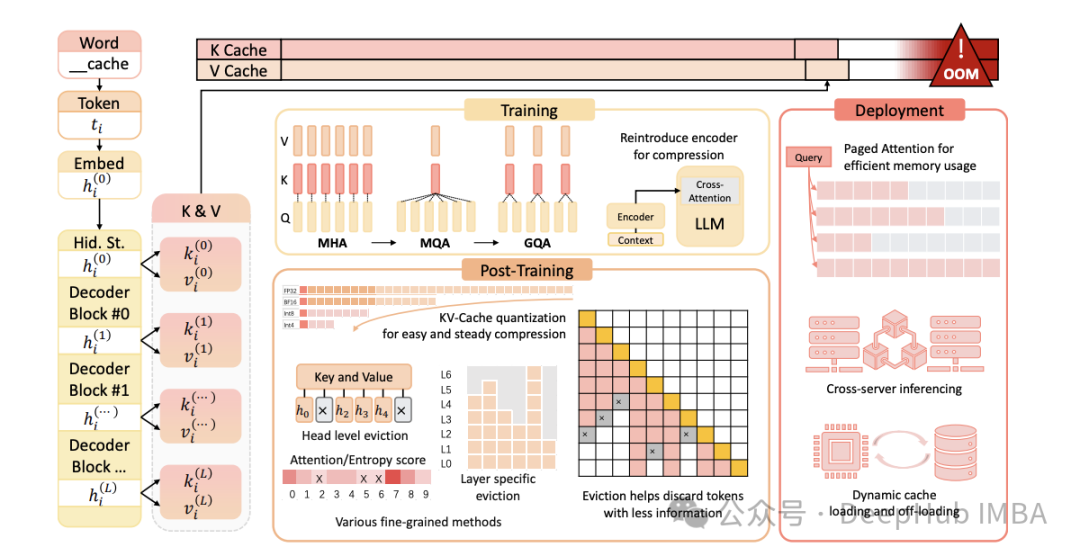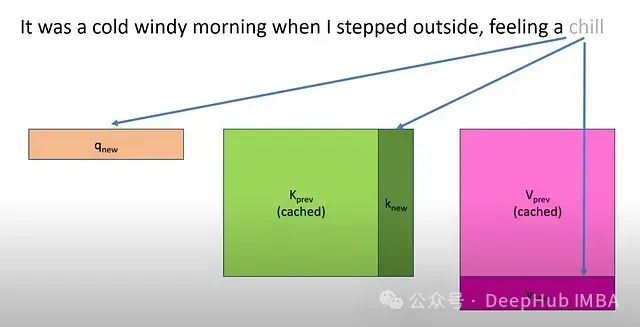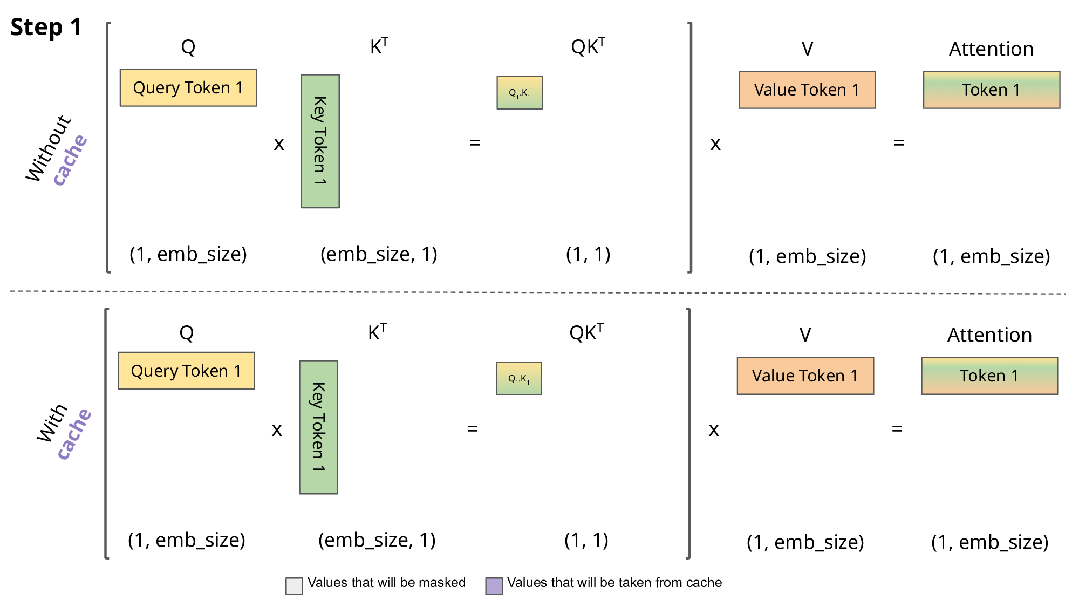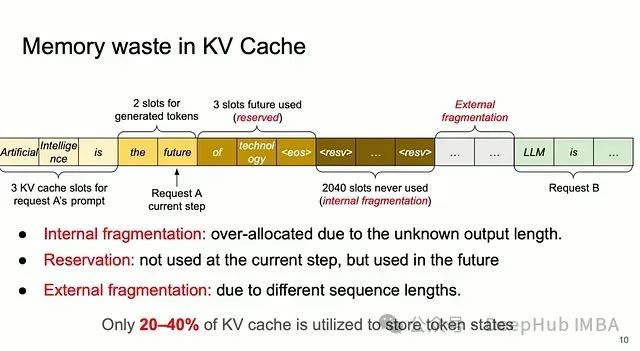随着大型语言模型(LLM)规模和复杂性的持续增长,高效推理的重要性日益凸显。KV(键值)缓存与分页注意力是两种优化LLM推理的关键技术。本文将深入剖析这些概念,阐述其重要性,并探讨它们在仅解码器(decoder-only)模型中的工作原理。
常规推理机制
首先,我们通过一个简单的例子来理解Transformer模型中典型的推理过程。假设我们需要生成短语:
“The quick brown fox jumped”
以下是常规推理的简化实现:
import numpy as np
# 简化的嵌入表示,仅用于演示
embeddings = {
'The': np.array([1, 0, 0, 0]),
'quick': np.array([0, 1, 0, 0]),
'brown': np.array([0, 0, 1, 0]),
'fox': np.array([0, 0, 0, 1]),
'jumped': np.array([1, 1, 0, 0])
}
# 权重矩阵(简化)
W_Q = W_K = W_V = np.array([[1, 0],
[0, 1],
[0, 0],
[0, 0]])
def compute_attention(self, input_words):
# 将单词转换为嵌入向量
E = np.array([embeddings[word] for word in input_words])
# 计算所有token的K和V矩阵
K = E @ W_K # 形状: (seq_len, 2)
V = E @ W_V # 形状: (seq_len, 2)
# 计算最后一个token的Q矩阵
Q = E[-1] @ W_Q # 形状: (1, 2)
# 计算缩放的点积注意力得分
scale = np.sqrt(2) # 缩放因子,为key/query维度(此处为2)的平方根
scores = (Q @ K.T) / scale # 形状: (1, seq_len)
# 应用Softmax函数,获得注意力权重
attention_weights = self.softmax(scores) # 形状: (1, seq_len)
# 将注意力权重应用于V矩阵
output = attention_weights @ V # 形状: (1, 2)
return output
以下是逐步生成的过程:
# 步骤1: 生成 "brown"
input_words_step1 = ['The', 'quick']
output_step1 = compute_attention(input_words_step1)
# 步骤2: 生成 "fox"
input_words_step2 = ['The', 'quick', 'brown']
output_step2 = compute_attention(input_words_step2)
# 步骤3: 生成 "jumped"
input_words_step3 = ['The', 'quick', 'brown', 'fox']
output_step3 = compute_attention(input_words_step3)
冗余计算:观察上述代码可以发现对于每个新生成的token:
- 需要为所有先前的token重新计算K和V矩阵。
- 矩阵的大小随着token数量的增加而增大。
- 存在大量不必要的重复计算。
KV缓存机制
当使用Transformer模型生成文本时,通过缓存键(K)和值(V)矩阵,可以显著优化推理过程。下图展示了KV缓存的工作原理:
在上图中:
q_new表示最新token的查询向量。K_prev和V_prev是从先前计算中缓存得到的键和值矩阵。k_new和v_new仅为当前新token计算。- 蓝色箭头表示如何利用缓存值和新值计算注意力。
以下是KV缓存的实现示例:
def compute_attention_with_cache(self, input_words):
"""使用KV缓存计算注意力"""
# 获取新token(序列中的最后一个单词)
new_word = input_words[-1]
e_new = embeddings[new_word]
# 计算新token的K和V矩阵
K_new = e_new @ W_K # 形状: (2,)
V_new = e_new @ W_V # 形状: (2,)
# 更新缓存的K和V矩阵
if self.cached_K is None:
self.cached_K = K_new.reshape(1, -1) # 形状: (1, 2)
self.cached_V = V_new.reshape(1, -1) # 形状: (1, 2)
else:
self.cached_K = np.vstack([self.cached_K, K_new]) # 形状: (seq_len, 2)
self.cached_V = np.vstack([self.cached_V, V_new]) # 形状: (seq_len, 2)
# 计算最后一个token的Q矩阵
Q = e_new @ W_Q # 形状: (2,)
# 使用缓存的K矩阵计算缩放的点积注意力得分
scale = np.sqrt(2) # 缩放因子,为key/query维度(此处为2)的平方根
scores = (Q @ self.cached_K.T) / scale # 形状: (1, seq_len)
# 应用Softmax函数,获得注意力权重
attention_weights = self.softmax(scores) # 形状: (1, seq_len)
# 使用缓存的V矩阵计算注意力输出
output = attention_weights @ self.cached_V # 形状: (1, 2)
return output
以下是逐步生成的过程:
# 步骤1: 生成 "brown"
input_words_step1 = ['The', 'quick']
output_step1 = compute_attention_with_cache(input_words_step1)
# 步骤2: 生成 "fox"
input_words_step2 = ['The', 'quick', 'brown']
output_step2 = compute_attention_with_cache(input_words_step2)
# 步骤 3: 生成 "jumped"
input_words_step3 = ['The', 'quick', 'brown', 'fox']
output_step3 = compute_attention_with_cache(input_words_step3)

比较有无KV缓存的推理计算
内存需求与挑战
我们来看一个使用典型模型参数的实际例子:
- 序列长度: 4096
- 层数: 32
- 注意力头数: 32
- 头维度: 128
- 精度: FP16 (2 bytes)
每个token所需的内存:
KV_cache_per_token = 2×num_layers×(num_heads×head_dim)×precision
= 2 × 32 × (32 × 128) × 2 bytes
= 2 × 32 × 4096 × 2 bytes
= 524,288 bytes
≈ 0.5 MB
KV缓存的低效性
尽管KV缓存显著提高了计算效率,但它也带来了内存管理方面的挑战。以下是三种主要的内存低效类型:
内部碎片
- 由因未知输出长度而导致的过度分配引起。
- 示例:在图像中,2040个槽位从未被使用。
- 影响:可能浪费高达60-80%的已分配内存。
- 解决方案:更精确的输出长度估计或动态分配策略。
预留浪费
- 为将来的token生成而预留的内存。
- 在图像中显示为“3 slots future used (reserved)”。
- 维持生成连续性的必要措施。
- 可以通过更好地预测所需的未来槽位来优化。
外部碎片
- 由处理具有不同序列长度的多个请求导致。
- 在不同请求之间创建内存间隙。
- 解决方案包括内存碎片整理和智能请求批处理。
如上图所示,通常仅有20-40%的KV缓存被用于存储实际的token状态。
分页注意力:解决内存低效的方案
为了应对这些内存挑战,可以采用分页注意力机制。
分页注意力是一种用于有效处理Transformer模型中长序列的技术,它通过将注意力计算分解为更小、更易于管理的“页”或“块”来实现。这种方法降低了内存消耗和计算复杂度,从而能够处理原本因过大而无法放入内存的序列。
def compute_attention_with_paging(self, input_words):
"""使用分页KV缓存计算注意力"""
# 获取新token(序列中的最后一个单词)
new_word = input_words[-1]
e_new = embeddings[new_word]
# 计算新token的K和V矩阵
K_new = e_new @ W_K # 形状: (2,)
V_new = e_new @ W_V # 形状: (2,)
# 确定当前页的索引
total_tokens = sum(len(K_page) for K_page in self.cached_K_pages) + 1
current_page_idx = (total_tokens - 1) // PAGE_SIZE
# 如果需要,初始化新页
if len(self.cached_K_pages) <= current_page_idx:
self.cached_K_pages.append([])
self.cached_V_pages.append([])
# 将K和V添加到当前页的缓存中
self.cached_K_pages[current_page_idx].append(K_new)
self.cached_V_pages[current_page_idx].append(V_new)
# 计算当前token的Q矩阵
Q = e_new @ W_Q # Shape: (2,)
# 仅在当前页内计算注意力
K_current_page = np.array(self.cached_K_pages[current_page_idx])
V_current_page = np.array(self.cached_V_pages[current_page_idx])
# 添加缩放因子,用于点积注意力
scale = np.sqrt(2) # 缩放因子,为key/query维度(此处为2)的平方根
scores = (Q @ K_current_page.T) / scale
# 应用Softmax函数,获得注意力权重
attention_weights = self.softmax(scores) # 形状: (1, current_page_size)
# 将注意力权重应用于当前页中的V矩阵
output = attention_weights @ V_current_page
return output
以下是逐步生成的过程:
# 步骤1: 生成 "brown"
input_words_step1 = ['The', 'quick']
output_step1 = compute_attention_with_paging(input_words_step1)
# 步骤2: 生成 "fox"
input_words_step2 = ['The', 'quick', 'brown']
output_step2 = compute_attention_with_paging(input_words_step2)
# 步骤3: 生成 "jumped"
input_words_step3 = ['The', 'quick', 'brown', 'fox']
output_step3 = compute_attention_with_paging(input_words_step3)
为何需要分页注意力?
- 内存约束:由于注意力矩阵的规模与序列长度呈平方关系,Transformer模型在处理长序列时面临严重的内存限制。
- 长序列处理:在诸如语言建模或文档摘要等任务中,序列可能非常长。
- 效率:通过以分页的方式处理注意力计算,可以将内存使用量保持在一个常量水平,从而不受序列长度的影响。
分页注意力如何工作?
- 分割序列:将输入序列分割成更小的块或页。
- 局部注意力:在每个页内计算注意力。
- 跨页注意力:可选地,允许有限的跨页注意力,以捕获页之间的依赖关系。
- 滑动窗口:使用重叠的页来确保连续性。
上述实现仅限于局部注意力,跨页注意力和滑动窗口的实现超出了本文的范围,将在后续文章中详细介绍。
分页注意力的讨论
优势
- 内存效率:注意力计算被限制在页大小内,内存使用量保持恒定,不受总序列长度的影响。
- 计算效率:降低了注意力计算的复杂度。
- 可扩展性:能够处理原本无法放入内存的超长序列。
权衡与考虑
- 上下文信息受限:模型会丢失跨页的一些依赖关系,这对于需要全局上下文的任务可能很重要。
可能的解决方案:
- 重叠页:允许页之间重叠一定数量的token,重叠区域的token可以关注前一页的token。
- 分层注意力:使用更高层次的注意力机制来连接跨页的信息。
重叠页、分层注意力、跨页注意力和滑动窗口的完整实现超出了本文的范围。
以下实现仅捕获局部注意力,作为示例不应在实际应用中使用:
# 本实现仅为演示和理解目的而设计的简化版本。
# 实际应用中需要更高效和可扩展的实现。
import numpy as np
embeddings = {
'The': np.array([1, 0, 0, 0]),
'quick': np.array([0, 1, 0, 0]),
'brown': np.array([0, 0, 1, 0]),
'fox': np.array([0, 0, 0, 1]),
'jumped': np.array([1, 1, 0, 0])
}
W_Q = W_K = W_V = np.array([[1, 0],
[0, 1],
[0, 0],
[0, 0]])
PAGE_SIZE = 2 # 演示用的小页尺寸
class AttentionWithCache:
def __init__(self):
self.cached_K = None # 形状: (seq_len, 2)
self.cached_V = None # 形状: (seq_len, 2)
self.cached_K_pages = [] # 包含K向量的页列表
self.cached_V_pages = [] # 包含V向量的页列表
def softmax(self, x, axis=-1):
"""
为x中的每组分数计算Softmax值。
包含数值稳定性改进。
"""
# 应用最大值减法以提高数值稳定性
x_max = np.max(x, axis=axis, keepdims=True)
exp_x = np.exp(x - x_max)
return exp_x / np.sum(exp_x, axis=axis, keepdims=True)
def compute_attention(self, input_words):
# 将单词转换为嵌入向量
E = np.array([embeddings[word] for word in input_words])
# 计算所有token的K和V矩阵
K = E @ W_K # 形状: (seq_len, 2)
V = E @ W_V # 形状: (seq_len, 2)
# 计算最后一个token的Q矩阵
Q = E[-1] @ W_Q # 形状: (1, 2)
# 计算缩放的点积注意力得分
scale = np.sqrt(2) # 缩放因子,为key/query维度(此处为2)的平方根
scores = (Q @ K.T) / scale # 形状: (1, seq_len)
# 应用Softmax函数,获得注意力权重
attention_weights = self.softmax(scores) # 形状: (1, seq_len)
# 将注意力权重应用于V矩阵
output = attention_weights @ V # 形状: (1, 2)
return output
def compute_attention_with_cache(self, input_words):
"""使用KV缓存计算注意力"""
# 获取新token(序列中的最后一个单词)
new_word = input_words[-1]
e_new = embeddings[new_word]
# 计算新token的K和V矩阵
K_new = e_new @ W_K # 形状: (2,)
V_new = e_new @ W_V # 形状: (2,)
# 更新缓存的K和V矩阵
if self.cached_K is None:
self.cached_K = K_new.reshape(1, -1) # 形状: (1, 2)
self.cached_V = V_new.reshape(1, -1) # 形状: (1, 2)
else:
self.cached_K = np.vstack([self.cached_K, K_new]) # 形状: (seq_len, 2)
self.cached_V = np.vstack([self.cached_V, V_new]) # 形状: (seq_len, 2)
# 计算最后一个token的Q矩阵
Q = e_new @ W_Q # 形状: (2,)
# 使用缓存的K矩阵计算缩放的点积注意力得分
scale = np.sqrt(2) # 缩放因子,为key/query维度(此处为2)的平方根
scores = (Q @ self.cached_K.T) / scale # 形状: (1, seq_len)
# 应用Softmax函数,获得注意力权重
attention_weights = self.softmax(scores) # 形状: (1, seq_len)
# 使用缓存的V矩阵计算注意力输出
output = attention_weights @ self.cached_V # 形状: (1, 2)
return output
def compute_attention_with_paging(self, input_words):
"""使用分页KV缓存计算注意力"""
# 获取新token(序列中的最后一个单词)
new_word = input_words[-1]
e_new = embeddings[new_word]
# 计算新token的K和V矩阵
K_new = e_new @ W_K # 形状: (2,)
V_new = e_new @ W_V # 形状: (2,)
# 确定当前页的索引
total_tokens = sum(len(K_page) for K_page in self.cached_K_pages) + 1
current_page_idx = (total_tokens - 1) // PAGE_SIZE
# 如果需要,初始化新页
if len(self.cached_K_pages) <= current_page_idx:
self.cached_K_pages.append([])
self.cached_V_pages.append([])
# 将K和V添加到当前页的缓存中
self.cached_K_pages[current_page_idx].append(K_new)
self.cached_V_pages[current_page_idx].append(V_new)
# 计算当前token的Q矩阵
Q = e_new @ W_Q # Shape: (2,)
# 仅在当前页内计算注意力
K_current_page = np.array(self.cached_K_pages[current_page_idx])
V_current_page = np.array(self.cached_V_pages[current_page_idx])
# 添加缩放因子,用于点积注意力
scale = np.sqrt(2) # 缩放因子,为key/query维度(此处为2)的平方根
scores = (Q @ K_current_page.T) / scale
# 应用Softmax函数,获得注意力权重
attention_weights = self.softmax(scores) # 形状: (1, current_page_size)
# 将注意力权重应用于当前页中的V矩阵
output = attention_weights @ V_current_page
return output
def compare_implementations():
print("原始实现:")
attention1 = AttentionWithCache()
# 使用原始方法处理序列
for i in range(len(['The', 'quick', 'brown', 'fox'])):
words = ['The', 'quick', 'brown', 'fox'][:i + 1]
output = attention1.compute_attention(words)
print(f"处理 {words} 后的输出:")
print(f"Output: {output}")
print("\nKV缓存实现:")
attention2 = AttentionWithCache()
# 使用KV缓存处理序列
for i in range(len(['The', 'quick', 'brown', 'fox'])):
words = ['The', 'quick', 'brown', 'fox'][:i + 1]
output = attention2.compute_attention_with_cache(words)
print(f"处理 {words} 后的输出:")
print(f"Output: {output}")
print("\n分页注意力实现:")
attention3 = AttentionWithCache()
# 使用分页注意力处理序列
for i in range(len(['The', 'quick', 'brown', 'fox'])):
words = ['The', 'quick', 'brown', 'fox'][:i + 1]
output = attention3.compute_attention_with_paging(words)
print(f"处理 {words} 后的输出:")
print(f"Output: {output}")
print(f"页数: {len(attention3.cached_K_pages)}")
print(f"当前页大小: {len(attention3.cached_K_pages[-1])}\n")
if __name__ == "__main__":
compare_implementations()
总结
KV缓存和分页注意力是提升LLM推理效率和可扩展性的重要技术。KV缓存通过消除冗余计算来优化计算过程,而分页注意力则解决了处理长序列时面临的内存限制。
随着模型规模和复杂性的不断增长,这些优化技术对于实际应用变得至关重要。深入理解和有效实施这些技术,可以显著提升LLM部署的性能和效率。
作者:Dewang Sultania